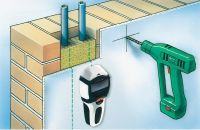Modern locators work in two ways. Some of them use it induction effect , caused by electromagnetic fields. This method is easiest to detect electric wires through which alternating current, i.e. network cables, flows . The locator finds an electromagnetic field around the wire that is generated by the current flowing. Such a cable is very easy to locate in the wall, even at a depth of a few centimeters.
The situation may be somewhat difficult if you need to locate metal objects through which no alternating current, i.e. dry conductors, reinforcement, etc., flows. For the detection of this type of elements, the fact that metals, especially steel, affect magnetic fields in their environment . Then the locator generates an electromagnetic alternating field. If the locator's sensor approaches the metal hidden in the wall, its vibration frequency changes. Then the measurement signal is analyzed and the result is indicated on the device.
The inductive method can not, however, detect any objects that are not metallic. For example, in a dry-mounted wall where there are wooden supports for a supporting structure, for example to hang a cabinet, another technique is required. He is used for this purpose capacitive technology . locator then sends a variable field with a very high frequency. The material in the sensor detection area absorbs part of the energy and thus weakens the electric field. This is recorded by locator as a measurement signal and converted accordingly, in such a way that the display shows the position of the center and the edge of the hidden element.
A powerful detector of wires with several integrated sensors is Laserliner MultiFinder Plus 080.965A
- The device is equipped with an LCD display with user interface. Thanks to this, MultiFinder can be operated easily and safely
- Acoustic and optical signals to search for items further facilitate service and guarantee high reliability in the location
- Easy to use: after automatic calibration, the instrument is ready for operation immediately

Laserliner MultiFinder Plus 080 detector.965A can detect live wires (up to 40 mm depth), locate non-ferrous metals (up to a depth of 50 mm, wood (up to 20 mm deep) and detect non-ferrous metals (up to a depth of 100 mm).
Find out more >>
Consent to the publication of // gulson
The situation may be somewhat difficult if you need to locate metal objects through which no alternating current, i.e. dry conductors, reinforcement, etc., flows. For the detection of this type of elements, the fact that metals, especially steel, affect magnetic fields in their environment . Then the locator generates an electromagnetic alternating field. If the locator's sensor approaches the metal hidden in the wall, its vibration frequency changes. Then the measurement signal is analyzed and the result is indicated on the device.
The inductive method can not, however, detect any objects that are not metallic. For example, in a dry-mounted wall where there are wooden supports for a supporting structure, for example to hang a cabinet, another technique is required. He is used for this purpose capacitive technology . locator then sends a variable field with a very high frequency. The material in the sensor detection area absorbs part of the energy and thus weakens the electric field. This is recorded by locator as a measurement signal and converted accordingly, in such a way that the display shows the position of the center and the edge of the hidden element.
A powerful detector of wires with several integrated sensors is Laserliner MultiFinder Plus 080.965A
- The device is equipped with an LCD display with user interface. Thanks to this, MultiFinder can be operated easily and safely
- Acoustic and optical signals to search for items further facilitate service and guarantee high reliability in the location
- Easy to use: after automatic calibration, the instrument is ready for operation immediately

Laserliner MultiFinder Plus 080 detector.965A can detect live wires (up to 40 mm depth), locate non-ferrous metals (up to a depth of 50 mm, wood (up to 20 mm deep) and detect non-ferrous metals (up to a depth of 100 mm).
Find out more >>
Consent to the publication of // gulson


